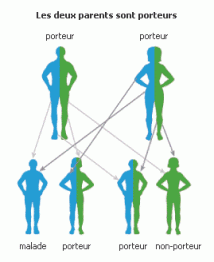mind helvetica, physician sans-serif; font-size: 1em; background-color: #92d2dd; border: medium solid #333333; text-align: center;">One can be affected by ataxia telangiectasia with parents who are not.
cialis helvetica,sans-serif; font-size: 1em; background-color: #92d2dd; border: medium solid #333333; text-align: center;">Each parent is carying an anomaly (in most cases).
AT is autosomal and recessive
Autosomal
that equally affects the two sexes.
Récessif
In our genetic heritage, we all have two alleles of the same gene, ie twice the copy of the gene. One comes from our mother and one from our father.
 A gene is called "dominant" when one altered allele is sufficient to express the abnormality. In this case, the parent who transmit it is ill too.
A gene is called "dominant" when one altered allele is sufficient to express the abnormality. In this case, the parent who transmit it is ill too.
A gene is called "recessive" if both abnormal copies of it are necessary to express a disease. In this case, neither parent has an anomaly whereas they are both carriers of a defective copy of the gene. This is the case of ATM: it requires that each parent carries an altered allele and transmit it to their child.
So there is 1 in 4 chance that the couple had a child with ataxia telangiectasia. In rarer cases, an allele may be altered during design, giving the same result.
Genetic counseling and the opportunity to make a prenatal diagnosis is possible, but only if a child is already concerned within the family and whether the mutation causes the disease is identified.